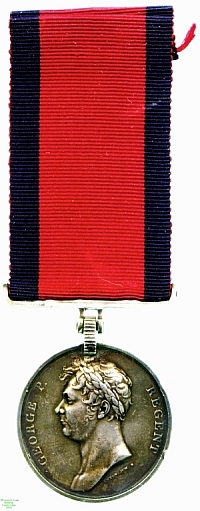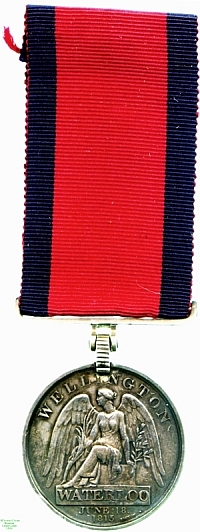
Obverse, a bust of George Prince Regent wreathed and facing left

Reverse, Victory seated on a plinth above a panel inscribed "WATERLOO"; the exergue is inscribed "JUNE 18 / 1815"

Obverse, a bust of George Prince Regent wreathed and facing left |

Reverse, Victory seated on a plinth above a panel inscribed "WATERLOO"; the exergue is inscribed "JUNE 18 / 1815" |
Most of the battles of the Napoleonic Wars, except those fought by Admiral Horatio Nelson, were not commemorated with the issue of medals at the time they were fought; instead combatants had to wait until 1848 to receive the Military or Naval General Service Medal. Almost the sole exception was the final defeat of the returned Emperor Napoleon I at Waterloo, on 18 June 1815 by the combined forces of Britain, Russia and Prussia. Napoleon's tactical planning was thwarted by the inability of his subordinate Maréchal Ney to shift the army of General Sir Arthur Wellesley, Duke of Wellington, from their positions, preventing the separation of the Coalition forces which thus continued to resist Napoleon's rapidly-raised forces and were eventually able to overturn the French tactical advantage and drive the Emperor from the field.
The battle has become an archetype of decisive defeat and the phrase "to meet one's Waterloo" has passed into the language. It is therefore perhaps not surprising that a medal was awarded to all British soldiers who had fought at Waterloo, or the two immediately prior battles at Ligny and Quatre Bras on 16 and 17 June respectively. Such an award was however unprecedented at the time. Soldiers present at these battles were also credited with two years' extra service to count for all purposes.
This medal was awarded to Private Hugh Gormley of the 6th or Inniskilling Dragoons; its award has been confirmed from the relevant Roll. Lester Watson purchased the medal at some point before 1928. It had previously been sold by the recipient's niece in November 1866, by which time she was living in Beaver Dam, Wisconsin, and believed herself to be Gormley's only surviving kin.
The Museum thanks Mr Sean Welch for information on the history of this medal.